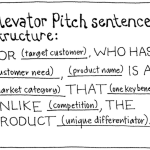As it was first explained to me, an “elevator pitch” is how you’d describe your business to a prospect in the amount of time you’d have during a shared elevator ride. When I first heard the term, I was working in a three-floor Silicon Valley building. That’s going to require some fast talking, I had thought.
However, having an elevator pitch and practicing it occasionally is a great practice for management in any small- or medium-sized business. The elevator pitch here at Voncor Communications? “We  help small- to mid-sized businesses figure out what they should be saying about their products or services and then help them develop the most efficient yet impactful ways to say it. Unlike other marketing communications consultancies, we offer pragmatic recommendations and really get to know our client’s businesses.” Should the elevator doors remain closed, we’ll add “We do this for small local businesses, firms that sell technology products or business-to-business services or, our particular passion, companies that sell recreational or commercial marine products and services.”
help small- to mid-sized businesses figure out what they should be saying about their products or services and then help them develop the most efficient yet impactful ways to say it. Unlike other marketing communications consultancies, we offer pragmatic recommendations and really get to know our client’s businesses.” Should the elevator doors remain closed, we’ll add “We do this for small local businesses, firms that sell technology products or business-to-business services or, our particular passion, companies that sell recreational or commercial marine products and services.”
How do you come up with an elevator pitch? Over time, we’ve discovered that answering the following six questions can be a good place to start. My advice is to round up a group of your employees (or friends and family members who know your business well if you haven’t yet got a group of employees) and have a stab at answering each of them:
1) What are you? Describe your business as if you were describing it to your grandmother. No corporate jargon and no waffle.
2) Who is your target customer? If you could only have one type of customer for the rest of your business life, who would that be?
3) Why would this customer use you? Think of all of the possible reasons why customers would use your product or service. List as many as possible, and have a vote on the main reasons.
4) What are your competitors’ advantages? Take three competitors that are keeping you awake at night; pretend you are in charge of those companies and list all the reasons why they are better than your company – be honest, brutal and factual. Then think about why you are better than the competitor; four or five clear unique selling points/competitive advantages should be clear after this exercise.
5) What’s your brand personality? Grab some recent magazines (travel, music, gossip, home, food, photography, sport), pass them out to the group and ask them to find one picture each that encapsulates the personality of your company. Then ask people to present their pictures, and words that describe them, to the group. Write up the main personality words and then narrow all the collated words down to four that describe your brand.
6) What’s your tone of voice? Once you have agreed on your brand personality keywords, select supporting words for the main brand personality words. For example, if brave is one of your main brand personality words, it could mean that pioneering, confident and spirited are good supporting words for your tone of voice.
These questions are the basis for every large-scale branding project I’ve been involved with for major international and national corporations; pulling together these answers should help you to better understand what your small company might mean to your customers. In addition, they provide the input needed to create an elevator pitch. Once you’ve spend some time with them, you can cobble together your pitch whose basic format goes something like this: For ______ (target customers) _______, who have _____ (customer need) ______, ______ (company or product name) _____ is the ______ (market or category name) ______ that _______ (key benefit) _______. Unlike ______ (competitive product or service) _____, our product ______ (point of difference) ______.
Once you’ve gotten the discipline of writing your elevator pitch, you can practice it and tailor it to unique scenarios.

Recent Comments